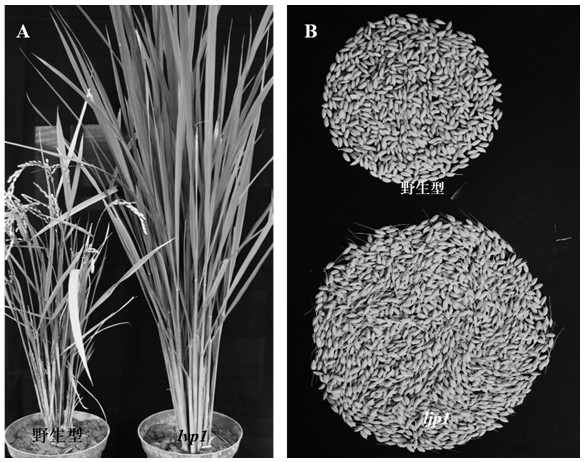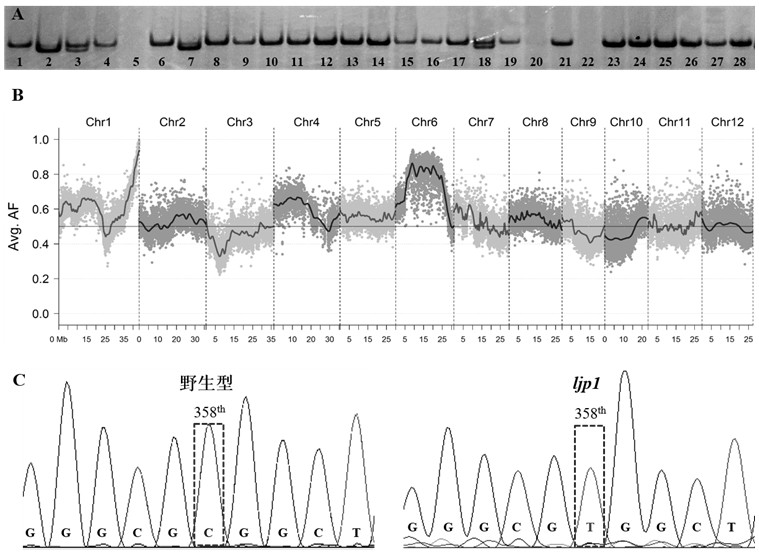Application of gene LJP1 for controlling growth period of rice
A rice growth period, gene technology, applied in the application, genetic engineering, plant genetic improvement and other directions, can solve problems such as genetic analysis difficulties, and achieve the effect of strong adaptability
- Summary
- Abstract
- Description
- Claims
- Application Information
AI Technical Summary
Problems solved by technology
Method used
Image
Examples
Embodiment 1
[0035] Embodiment 1: Rice LJP1 gene cloning
[0036] 1. Rice material and targeting groups:
[0037] like figure 1 The indicated rice mutant ljp1 Obtained by the inventors by means of radiation mutagenesis, the original wild-type parent is the japonica rice variety Nipponbare. Will ljp1 The mutant was crossed with the wild-type variety DZ60, F 1 Generation selfing, get F2 population, at the rice heading stage according to ljp1 389 plants were selected as the mapping population for the mutant phenotype.
[0038] 2. Location using rice microsatellite markers LJP1 Gene:
[0039] The total DNA of rice was rapidly extracted by the rice micro-method. Take about 0.3 grams of rice leaves, put them into a 1.5ml centrifuge tube, freeze them with liquid nitrogen, and extract DNA quickly. The obtained DNA is dissolved in 100 ul ultrapure water. Using the positioning method of DNA pool, preliminary positioning LJP1 Gene. According to the published rice microsatellite gene...
Embodiment 2
[0042] Embodiment 2 complementary experiment
[0043] 1. Construct the complementary experimental vector.
[0044] Nipponbare LJP1 The sequence of the gene was constructed using the pCAMBIA1300 vector with added restriction sites as image 3 Complementation experimental vectors for the indicated candidate genes. The specific process of vector construction is: in the candidate LJP1 Design a pair of primers with enzyme cutting sites for the gene region and the promoter region, use high-fidelity enzymes to perform high-fidelity PCR amplification and sequencing, select clones with completely correct sequences, and after enzyme digestion and ligation, construct the following: image 3 The indicated vector was then transformed into Agrobacterium. The DNA sequence of the complementary vector is 3420bp. The primers used to amplify the DNA sequence of the complementation experiment are: forward primer sequence: CGGAATTCATTTCTATGCGGTACAGTTTT, reverse primer sequence: CGGAATTCGTATTT...
Embodiment 3
[0047] Example 3 Cultivation of rice germplasm with long growth period, light insensitivity and high yield
[0048] Will ljp1The mutants were crossed with Zhonghua 11 and Zhonghua 15 respectively to obtain F1 generation. Taking Zhonghua 11 and Zhonghua 15 as recurrent parents, after multiple generations (more than 5 generations) of backcrossing, as shown in Table 1, they were screened out under natural short-day conditions in winter in Sanya City, Hainan Province (about 10 h sunshine at the booting stage). / day) and planted under the natural long-sunlight conditions in Fuzhou City, Fujian Province in summer (about 14 h sunshine / day at the booting stage), it has the characteristics of long growth period, light insensitivity, many tillers, and high yield, but other traits are consistent with the backcross parent strain. At the same time, the total DNA of rice was rapidly extracted by the rice micro-method, and PCR was used to amplify the ljp1 The sequence of the mutation si...
PUM
| Property | Measurement | Unit |
|---|---|---|
| Diameter | aaaaa | aaaaa |
Abstract
Description
Claims
Application Information
 Login to View More
Login to View More - R&D
- Intellectual Property
- Life Sciences
- Materials
- Tech Scout
- Unparalleled Data Quality
- Higher Quality Content
- 60% Fewer Hallucinations
Browse by: Latest US Patents, China's latest patents, Technical Efficacy Thesaurus, Application Domain, Technology Topic, Popular Technical Reports.
© 2025 PatSnap. All rights reserved.Legal|Privacy policy|Modern Slavery Act Transparency Statement|Sitemap|About US| Contact US: help@patsnap.com



